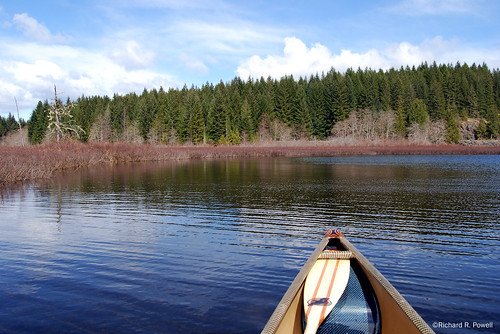Atlas of Canada Link: Whymper Lake
Latitude and Longitude: 50o 2' 59" N - 125o 35' 59" W
Trip Date: April 18, 2008
It’s funny where you end up sometimes. I headed first to Snakehead Lake but found the lake whipped up by a strong wind from the North, so I headed to Camp Lake, but loggers and equipment were everywhere and the crew boss was not happy with me “bombing along” his road, so I left and headed back to the Sayward Forest again. My son and I paddled there the week before and on our way past Whymper Lake I said to him, “that looks nice.” So I went to Whymper.
I think it is fairly safe to say that almost no one goes to Whymper Lake on purpose. Paddlers on the Sayward Forest Canoe Route must pass through the lake, but it would take a determined small water paddler like me to find this little jewel with so many larger gems near by. There is no boat launch ramp, no trail to the lake edge, only the portage trail which is all but unseen from the roadside.
I decided to see if there was a way to enter the creek above the lake so that I could paddle down the bushy corridor leading to the lake. I found an overgrown road leading to a crumbling old bridge but the alders were completely covering the road and I was only able to pull the Tracker off the main road enough to unload. A short bushwhack to the creek edge and I was away.

The lake is essentially a swelling of the creek and I could always feel the tug of the current on the hull, even in the largest flat part of the lake. The wind was gusty, but such a small body of water does not allow any kind of real chop to develop and I found that if I cruised near the shore, the wind hardly bothered me.
I paddled around for about two hours looking at the new bulrush leaves poking out of the mud, watching migrating water fowl pass overhead, and examining a profuse amount of what I later identified as Sweet Gale, or Myrica gale. The waxy catkins of this aromatic wetland shrub appear before the leaves and these catkins were just cracking open in the spring sunshine. The golden hue of them lit the grey boarders of the lake with a gentle glow.
Sweet Gale is reported to be on the badge of the Campbell clan, and having found this shrub in great abundance this close to Campbell River seemed apropos.
According to Mrs. M Grieve, “The leaves (of Sweet Gale) are often dried to perfume linen, etc., their odour being very fragrant, but the taste bitter and astringent. The branches have been used as a substitute for hops in Yorkshire and put into a beer called there 'Gale Beer.' It is extremely good to allay thirst. The catkins, or cones, boiled in water, give a scum beeswax, which is utilized to make candles. The bark is used to tan calfskins; if gathered in autumn, it will dye wool a good yellow colour and is used for this purpose both in Sweden and Wales. The Swedes use it in strong decoction to kill insects, vermin and to cure the itch. The dried berries are put into broth and used as spice. In China, the leaves are infused like tea, and used as a stomachic and cordial.”Gotta love a shrub that can do all that.
I look forward to visiting this area again after the plants leave out. I noticed Caddisfly larvae moving on the muddy bottom and would expect this to be a productive section of stream for the fly angler even though my dry fly arrangement did not produce any takers and I had left my wet fly reel in the vehicle.
If you decide to seek out this lake be aware that the shoreline is composed of fragile bog plants. I recommend doing as I did and enter the lake via the stream where the creek edge is less vulnerable to human impact.
For more photos go to: http://www.flickr.com/photos/stillinthestream/
and click on the 100 Lake Project link.
©Richard R. Powell


 First paddle: We took the canoe out first as a tandem and I was immediately impressed with the tracking, stability, and movement through the water. There was very little bow wake until we really pushed it, and the progress along the marsh area we explored was quiet. It was the sort of situation in which you appreciate the boat’s smooth long glide. The tracking has to be the most significant performance feature compared with my other canoes. It felt similar to the tandem Kayak I have paddled in often, going steady and straight with minimal effort required to keep it on track. I was able to take a number of photographs while my son paddled in the bow. He made some corrections and kept the boat on course. The seats were still comfortable after two hours on the water.
First paddle: We took the canoe out first as a tandem and I was immediately impressed with the tracking, stability, and movement through the water. There was very little bow wake until we really pushed it, and the progress along the marsh area we explored was quiet. It was the sort of situation in which you appreciate the boat’s smooth long glide. The tracking has to be the most significant performance feature compared with my other canoes. It felt similar to the tandem Kayak I have paddled in often, going steady and straight with minimal effort required to keep it on track. I was able to take a number of photographs while my son paddled in the bow. He made some corrections and kept the boat on course. The seats were still comfortable after two hours on the water.












